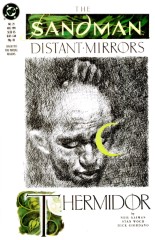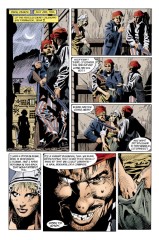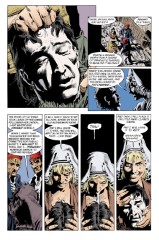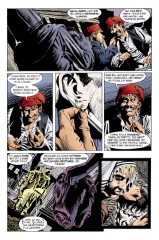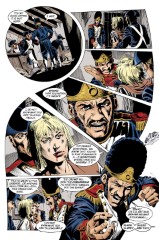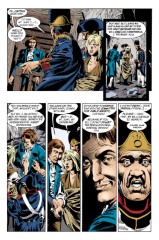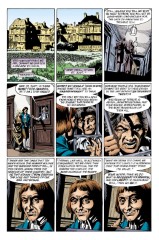Issue 29 : "Thermidor"
Neil Gaiman, Stan Woch, and Dick Giordano
- First story in anthology, Distant Mirrors
- Third story reprinted in trade paperback Fables & Reflections
- Audible Act II Chapter 9
Sources: A note in Sandman #31 indicates that the title of this anthology came from Barbara Tuchman's text A Distant Mirror: The Calamitous 14th Century.
This note also indicates that Simon Schama's History of the French Revolution and John Paxton's Companion to the French Revolution were two of Gaiman's major influences for this story. Additional help was derived from The Encyclopedia Britannica, Ninth Ed., 1890 (!).
Page 1#
Panel 1
Though this does not resemble the house of Sandman #1, this is 'Fawney Rig', the future dwelling of Roderick Burgess. Neil declaims: "It is the same house: more wings and bits were added in 1810 (by Lady Johanna) and in 1875 (by the industrialist from whom Burgess later built the house)."
Gaiman has also said that the house was named by Lady Johanna after the manner in which she acquired it. Unfortunately, this is not explicated here. Wych Cross is probably related to the wych elm.
Panel 2
Dream and the reader met Lady Johanna in Sandman #13.
Panel 4
As will be seen in a later issue, Dream once swore to have nothing to do with Orpheus, who is his son; he acts covertly, through an agent, in the case to salve his pride.
Page 2#
Panel 1
The leaders of the French Revolution instituted a new calendar to emphasize the break with the old ways of government. They began a new numbering of years, redivided the year into new months, and renamed all the days. Thermidor was, obviously, one of the months. See the Appendix for more details.
Panel 5
Montmarat is a neighborhood in Paris, which is notable for a number of cemetaries with the graves of famous personages.
Panel 6
Is there significance in the thug's one unseeing eye?
Page 3#
Panel 3
Aristo: from aristocrat; the Revolution overthrew the old feudal lords, most of whom died under the guillotine.
Panel 4
The Committee was the governing body from France during much of the Revolution. It was more autocratic than the king had been, and remained in power by drinking the blood of its enemies, giving rise to the name of the era, the "Reign of Terror".
Page 4#
Panel 5
This is from a popular song of the Revolution in Paris.
It translates as "That (they?) will go, the aristocrats, to the lamppost." Public lighting was a recent civic improvement, and quite handy for dispatching unwanted nobility. The song may be found in Les Miserables. Note the visible spine and trachea/esophagus of the head.
Page 5#
Panel 4
Will the earlobe grow back, though?
Panel 9
We have seen earlier that Orpheus is Dream's son. The Sandman Special #1 will have Orpheus' story, although we never learn how his head came to be in Paris.
Page 6#
Panel 4
Hein: French for "Eh?"
Panel 5
Bonchance: Good luck. This is a name; "bonne chance" is "good luck" in spoken French.
Panel 6
Lots of cabbages in this issue... In french, le chou, pronounced more or less like "shoe". Often used as a term of endearment, such as in "mon petit chou", my little cabbage. The Carmagnole is a revolutionary dance from the countryside. Some lines:
"Dansons la Carmagnole, vive le son, vive le son
Dansons la Carmagnole, vive le son du canon"
"Let's dance the Carmagnole, hail to the sound, hail to the sound
Let's dance the Carmagnole, hail to the sound of the gun"And a description from Dickens:
"While those were down, the rest linked hand in hand, and all spun round together : then the ring broke, and in separate rings of two and four they turned and turned until they all stopped at once, began again, struck, clutched, and tore, and then reversed the spin, and all spun round another way. Suddenly they stopped again, paused, struck out the time afresh, formed into lines the width of the public way, and, with their heads low down and their hands high up, swooped screaming off. No fight could have been half so terrible as this dance. ... This was the Carmagnole."
--Dickens, A Tale of Two Cities
Page 7#
Panel 1
The Revolution established the honorific "Citizen", much as the Leninists would later adopt "Comrade". Antoine Louis Leon de Richebourg de St. Just (1767-1794) was active in the Committee of Public Safety and organized the Terror. While the comic's depiction vaguely resembles his portrait, St. Just was noted for having an effeminate appearance which is not apparent in the comic rendering.
Page 8#
Panel 1
The Palace of Luxembourg is in Paris, and is named after a European royal family, which is also eponymic of the small European country Luxembourg, located between France, Belgium, and Germany.
Panel 2
Maximilien Francois Marie Isidore de Robespierre was the head of the Committee of Public Safety, and the virtual dictator of the country.
Panel 3
Prairial is another new month; the law was as St. Just states it.
Panel 4
Is the quote original to St. Just?
Panel 5
Recall that "make love" used to be what we'd call flirting or romancing, and did not have to involve actual intercourse. However, the French "make love", faire l'amour, has always had the sense of sexual intercourse (or so I am told). A lover, courtly romance style, was "amant", at least up to a century before.
Panel 6
Tricoteuses: knitters, feminine, from tricoter, to knit.
Probably a reference to Madame Defarge, a character in the novel A Tale of Two Cities by Charles Dickens, which is set partially in revolutionary France.
Defarge was a spy and a trictoteuse, concealing secret messages in her scarves while she watched the Terror, needles a-clicking. Tale would be called a historical novel nowadays, as it features fictional doings against a backdrop of the real persons and events of the era.
Page 9#
Panel 5
Thomas Paine was an Englishman whose influential pamphlet Common Sense lent strength to the American Revolution. His Rights of Man sparked much interest in the French experiment with liberty, and was answered by Burke in Reflections on the Revolution in France. While Paine was in England, he was threatened by intrigue, and fled to France, where he had just been elected as a representative from Calais. He was involved in the process of the Revolution as well as being on the American staff drafting texts on freedom. He was a thorn in Robespierre's side as a devoted follower of liberty and democracy. Accordingly, when the revolutionaries perceived foreign plots against them, he was caught up in the Terror as a scapegoat and was imprisoned.
Panel 7-9
St. Just is quoting Common Sense.
Page 10#
Panel 6
Paine indeed escaped the guillotine as described here; he was freed following Robespierre's fall and resumed service in the French government as long as the Revolution endured. Quintidi: "Day Five", in the new calendar.
Panel 8
Fabre d’Églantine was a French actor, poet, dramatist and politician who lived in the 18th century. As mentioned by St Just, he devised the revolutionary calendar, and voted for the execution of King Louis XVI. He was accused of corruption and conspiracy and guillotined in 1794.
Georges Danton was a French lawyer and a leader of the French Revolution. He was known for his powerful speeches and his role in overthrowing the monarchy. He was also a friend and later a rival of Robespierre, who had him sent to the guillotine.
Page 12#
Panel 1
This passage would tend to indicate that St. Just and Johanna did have sex, confirming the French interpretation.
Panel 2
St. J___: A period shorthand way of writing a name, also providing protection for the writer when writing of important people and sensitive incidents; there are several examples to come. It may be most familiar to American audiences through the works of Edgar Allan Poe.
Panel 4
Place de la Revolution: Now la Place de la Concorde or possibly Place St Michel. No ref on the dance of the beheaded bodies.
Page 13#
Panel 1
True Constantines, of whom Lady Johanna is one, are the sole surviving member of a twin birth. I have a painting ref for Robespierre which vaguely resembles this depiction.
Panel 2-3
Charles Genevieve Louis Auguste Andre Timothee d'Eon de Beaumont, le Chevalier d'Eon, 1728-1810. d'Eon masqueraded as lady in waiting under the name Lia de Beaumont at the court of the Czarina in 1755, but was in reality a French spy. The Chevalier was a distinguished soldier and diplomat, including ambassador to England. d'Eon's sex (and sexuality) was indeterminate, and was the subject of much discussion and wagering in England and France. Doctors in attendance at a post-mortem examination disagreed, some postulating that d'Eon was male, others that d'Eon was hermaphroditic.
d'Eon's exploits are in some ways reminiscent of the Scarlet Pimpernel, who has been referred to before.
There have been several books written by or about the Chevalier, including volumes of d'Eon's diplomatic memoirs, but an entry in the People's Almanac is probably most accessible to a mass audience.
Sir Frances Dashwood seduced Empress Anne of Russia in 1729 by pretending to be King Charles XII of Sweden. Dashwood lived from 1708-1781, and founded the historical Hellfire Club, a model for Marvel Comics' version of same. The Hellfire Club included Benjamin Franklin as one of its members and featured clerically-themed orgies, in which the attendees were dressed as priests and nuns. Dashwood was also a Satanist and a politician.
No reference for the Medenham Monks, though this is likely to be the same group as the Hellfire Club.
Panel 6
Lady Johanna, in this panel, and also page 15 panel 5, in drawn in a manner which recalls to me Berni Wrightson's Linda Holland, from Swamp Thing.
Page 15#
Panel 1
William Pitt the Younger was Prime Minister of Great Britain from 1783-1801 and 1804-1806. He organized England's part in the war of reaction against revolutionary France and served the Revolution as a villain upon whom problems could be blamed.
Page 16#
Panel 2
Note the corvine bird flying overhead. This is Jessamy, one of Matthew's predecessors. Note also the blood or blood-colored water; Constantines bear a heavy load of death, which the blood symbolizes.
Page 18#
Panel 2-5
This is reminiscent of Edgar Allan Poe's The Purloined Letter.
Page 19#
Panel 2
Note the slip of the tongue. St. Just is holding a pomander under his nose, a ball containing perfume, used to ward off infection (so believed) and stenches. Note that regular bathing, and the changing of clothes and underwear had not yet come into vogue.
Page 20#
Panel 1
The Hebrus: A Greek river, now called the Maritsa. In myth, Orpheus' head was in fact cast into the Hebrus.
Panel 6
Messire: An ancestral form of the modern "monsieur".
Page 21#
Panel 3
Will-they or nil-they: Parallel structure to will-he or nil-he, whence willy-nilly. Romany: Gypsy.
Page 23#
- On 9 Thermidor [1794], St. Just was interrupted after saying but a few words of his speech and fell silent under a torrent of verbal lashing. In the subsequent uproar, the anti-Robespierre conspirators made their move. The Committee ordered the arraignment of Robespierre, St. Just, and Couthon; the arrest of Dumas, President of the Revolutionary Tribunal; and the removal of Hanriot from command of the National Guard. The five were later released, only to be declared outlaws, their lives forfeit. Before dawn the next day, the Guardsmen came to take them again. St. Just yielded without resistance, but Robespierre either attempted suicide or was shot in the jaw by a soldier who later boasted of shooting the tyrant. The shattered jaw was papered, for there was no linen to staunch the wound; a surgeon later bandaged it and extracted two or three loose teeth. The bandage was indeed torn from his mouth just before his death under the guillotine.
Page 24#
Panel 1
Naxos: Confirmed to be a Greek island, one of the Cyclades, between Greece and Turkey.
Panel 4
Refer back to page 9, and the quote from Common Sense.
Credits
- Originally collated and edited by Greg Morrow.
- A number of people chimed in with complete lists of the Revolutionary months or explanations of their names, including Laurent Amon (lga@sandman.stanford.edu), Stephane "Alias" Gallay (SATELLITE@eldi.epfl.ch), David "Orb-Man" Henry dhenry@plains.NoDak.edu, Col. G.L. Sicherman (gls@windmill.att.com), Michael Kelly (mkelly@moliere.helios.nd.edu) and Jim W Lai (jwtlai@jeeves.waterloo.edu). See the Appendix.
- David Goldfarb (goldfarb@ocf.berkeley.edu) recalled the new name of the Place de la Revolution, and made an observation on the relationship of Dream and Orpheus.
- Laurent also gave a number of French lingual and cultural references, as well as a ref for d'Eon and Naxos. Stephane also gave some valuable French refs.
- The Colonel also added some historical bits about lampposts, the Carmagnole, William Pitt; some geographical bits about Greece; and identified a quote I should have caught.
- Jim added some commentary about blind eyes, missing rings, Thomas Paine, St. Just's appearance, William Pitt, bloody water, and the fall of the Terror.
- Tanaqui C. Weaver (cen@oxford.vax.ac.uk) added some bits about Fawney Rig (a clarification from Neil Gaiman), as well as about Thomas Paine, literary techniques, and Greek Geography.
- "Where The Hell Is" Bill Sherman (sherman@math.ucla.edu) wondered about Montmarat, and reffed up Madame Defarge and the Chevalier D'Eon.
- John "The Laughing Priest" Goodrich (J_GOODRICH@unhh.unh.edu) identified the pomander.
- Michael "Encyclopedia" Bowman mbowman@andromeda.rutgers.edu added information on William Pitt and the fall of Robespierre.
- Rick Jones (No, not the imaginary one) albert@crick.ssctr.bcm.tmc.edu confirmed the existence of Montmarat and added information about Defarge.
- Kenneth Freeman (kfree@fatcity.cts.com) added some information on pomanders.
- The Secret Man (tsm@access.digex.com) also speaks of pomanders, and adds some Poe.
- Richard Munn updated some revolutionary references.
Appendix I:
The Revolutionary months are, with corresponding dates and sense:
| Revolutionary Month | Julian Date | Translation |
|---|---|---|
| 1 Vendémiaire | 22 September | Vintage^ |
| 1 Brumaire | 22 October | Fog |
| 1 Frimaire | 21 November | Frost |
| 1 Nivôse | 21 December* | Snow |
| 1 Pluviôse | 20 January | Rain |
| 1 Ventôse | 19 February | Wind |
| 1 Germinal | 21 March | Buds, or Seed |
| 1 Floréal | 20 April | Flowers or Blossom |
| 1 Prairial | 20 May | Meadows or Pasture |
| 1 Messidor | 19 June | Reaping or Harvest |
| 1 Thermidor+ | 19 July | Heat |
| 1 Fructidor | 18 August | Fruit |
Note that the months' names have similar endings for months in the same season, and the calendar begins on the fall equinox. (Historically, most calendars have begun at the winter solstice or spring equinox.)
^ Referring to wine-making rather than the "old quality" sense.
* At least one source claims a date of 22 December.
+ Alternately, Fervidor.
Some comments on month names: If I recall my high school French properly, 'frais' means 'cool' and 'froit' means 'cold'; both would appear to be akin to Frimaire. 'Neiger' means 'to snow', which does not look like Nivôse, but I'm still willing to bet that they're from the same root word. 'Pluvoir' means 'to rain', and obviously fits with Pluviôse. Wind is indeed something like 'vent', to go with Ventôse. Germinal is obviously from the same root as 'germinate', meaning to sprout. Prairial is akin to prairie, which is roughly the same as 'meadow'. Messidor: Late June-early July is an awfully peculiar time to be harvesting.... Thermidor is obviously from the same root as 'thermos', meaning heat. Fructidor is from the same root as fruit, and that root originally meant reproduction of any sort, as opposed to the most common modern meaning, which restricts fruiting to plants.
Last modified by Richard Munn on 2023-08-22 - Updated some revolutionary references
[edit this page] [page history]
